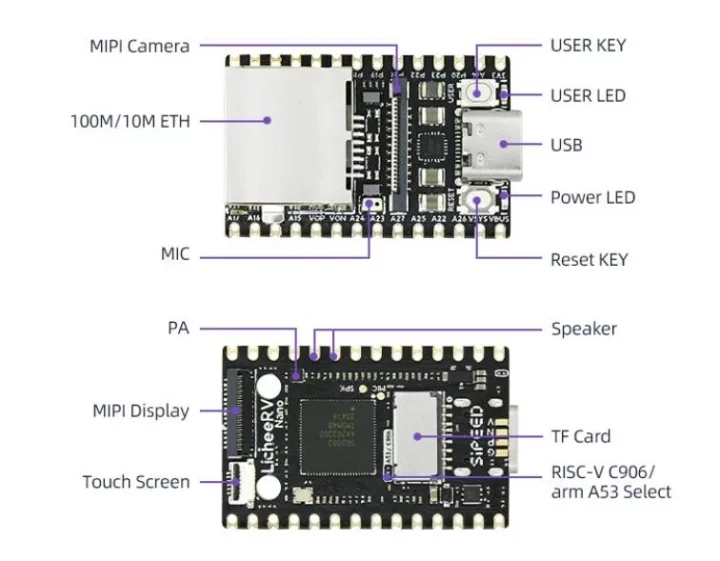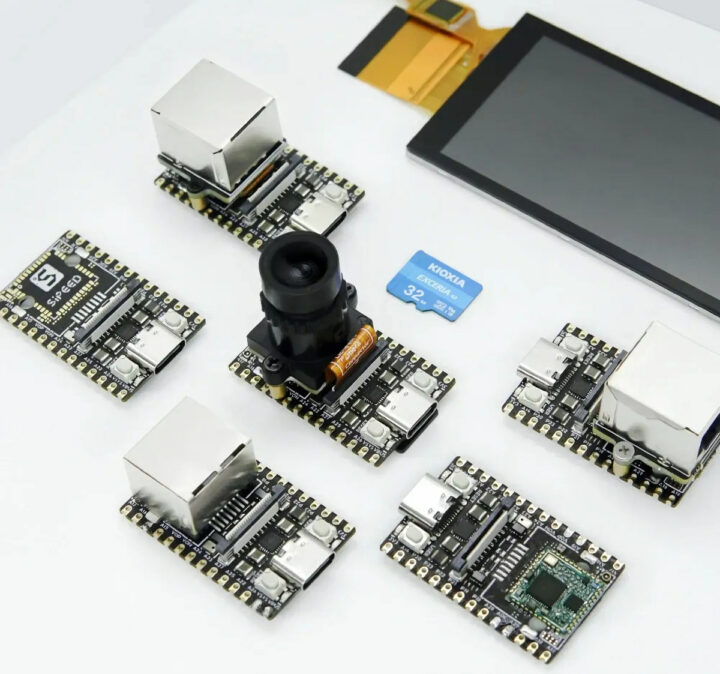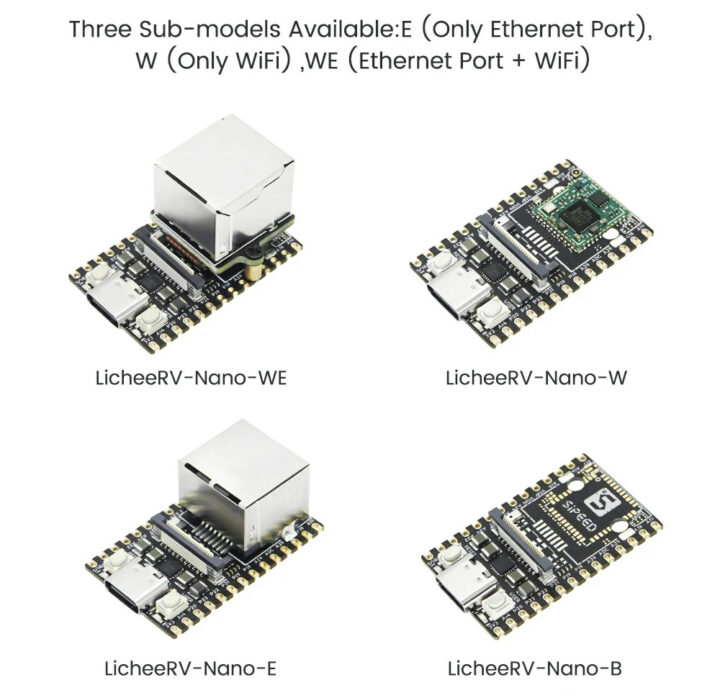When I wrote about the SOPHGO SG2002 (and SG2000) RISC-V, Arm, and 8051 AIoT processor yesterday, I noted several boards were in development, but I had not noticed the Sipeed LicheeRV Nano (Beta) was already available for sale, so let’s have a closer look.
It’s an inexpensive, tiny camera and display board running Linux with optional support for WiFi 6 and 10/100M Ethernet connectivity which somewhat reminds me of the Breadbee SBC based on MStar MSC313E Camera SoC. Sipeed also provides accessories such as a camera module and a touchscreen display to quickly get started.
LicheeRV Nano specifications:
- SoC – SOPHGO SG2002
- Main core – 1GHz 64-bit RISC-V C906 or Arm Cortex-A53 core (selectable)
- Minor core – 700MHz 64-bit RISC-V C906 core
- Low-power core – 25 to 300MHz 8051 MCU core
- NPU – 1 TOPS INT8, supports BF16
- Integrated 256MB DDR3 (SiP)
- Storage – MicroSD card slot and SD NAND pads (both bootable)
- Display Interface – 31-pin connector for 2-lane MIPI DSI output + 6-pin capacitive touchscreen connector
- Camera Interface – 22-pin connector for 4-lane MIPI CSI input
- Audio
- Output – Onboard PA amplifier for up to 1W speakers
- Input – Onboard analog microphone
- Networking
- Boards with E suffix – 100Mbps Ethernet RJ45 jack
- Boards with W suffix – dual-band WiFi 6 and Bluetooth 5.4
- USB – 1x USB 2.0 OTG Type-C port
- Expansion – 2x 14-pin 2.54 pitch headers with GPIOs
- Misc
- RST button, BOOT button
- Power LED, User LED
- Power Supply – 5V via USB-C port
- Dimensions – 35.56 x 22.86 mm
 Sipeed says it provides for Buildroot Linux and Debian operating systems, but I can only see the code and instructions to make an Alpline Linux image with Buildroot on GitHub. The Wiki links to many more resources including the datasheets, schematic diagrams, and mechanical drawings, as well as SOPHGO SG2002/SG2000 toolchains, Linux SDK, and AI accelerator SDK.
Sipeed says it provides for Buildroot Linux and Debian operating systems, but I can only see the code and instructions to make an Alpline Linux image with Buildroot on GitHub. The Wiki links to many more resources including the datasheets, schematic diagrams, and mechanical drawings, as well as SOPHGO SG2002/SG2000 toolchains, Linux SDK, and AI accelerator SDK.
We also learn some of the limitations of the beta version of the LicheeRV Nano currently for sale:
- The beta version hardware (70405) NPU only supports operation at 0.5T, running at 1.0T does not guarantee the stability of the board.
- The WiFi of the beta version hardware (70405) has not been fully optimized yet, resulting in lower speeds. We appreciate your understanding.
Four models are currently available with the LicheeRV Nano B (no wired or wireless connectivity), LicheeRV Nano E (Ethernet), LicheeRV Nano W (WiFi 6), and LicheeRV Nano WE (Ethernet+WiFi 6).
The LicheRV Nano board sells for just $8.90 to $13.90 plus shipping depending on the selected model, but you can also get a GC4653 camera sensor ($8.90) or a 7-inch touchscreen display ($29.90) if needed.

Jean-Luc started CNX Software in 2010 as a part-time endeavor, before quitting his job as a software engineering manager, and starting to write daily news, and reviews full time later in 2011.
Support CNX Software! Donate via cryptocurrencies, become a Patron on Patreon, or purchase goods on Amazon or Aliexpress. We also use affiliate links in articles to earn commissions if you make a purchase after clicking on those links.






Initially I thought the “selectable” main core was selectable when you order the board, but no, the chip really contains two main cores, both an ARM and a RISCV, that you choose between using the CPUSEL input pin. What a surprising design! That’s quite interesting in fact, it means that an A53 license has become cheap enough to integrate it along with the RISCV without significantly inflating the price.
The CPU datasheet also mentions support for SPI NOR up to 256M, though I have not yet figured if it’s from SPI pins available on the board or other ones.
These boards are really interesting. I was thinking about building a small ethernet-connected power delivery controller for up to 8 USB plugs, and was hesitating between ESP32 and other chips, but that might be one option as well.
In fact, we use a tiny 0201 R to select A53/C906, so you don’t need solder, just use 2B pencil to switch~ (2B pencil paint is about 1~2K ohm)
Yep I guess so 😉
IIRC, the previous chip in this family used the SD lines for the SPI flash (NAND if you want to store a reasonable amount of data). Maybe this one is similar?
I think it’s the same, yes. I’ll run some tests when I receive all of this.
FYI the prices I’m seeing here are $11 to $15, and shipping to France adds $6.34. That’s still reasonable but more expensive, I don’t know why aliexpress prices change over time.
hi, it is not changes over time, but changes over area, different country/area have different tax policy/express fees.
OK makes sense indeed. Thanks for the explanation.
In your case, it’s because of the VAT because you are in Europe.
But I’ve also seen prices vary depending on countries and whether Aliexpress applies a random discount.
Yes, I don’t always understand Aliexpress. Anyway, I ordered one of each (eth and wifi). They indeed remind me of the breadbee (without local flash though).
@zepan, since you seem to be the maker, what type o SD NAND should work on such boards ? For example I found this: 25N01GVZEIG (1Gbit), is it expected to be supported ? Does anything need to be done on the software side (e.g. u-boot), does it require specific formatting or should it be used like an SD card and partitionned etc ?
Hi, just treat it as normal TF card, burn it via sdcard reader first, and then you can use uboot to upgrade it. also we have win tools to flash sdnand/tfcard.
Windows tools to flash a Linux OS?
OK, good to know, thank you. I’ll buy one and make some experiments.
Does this actually have 2 entire main core’s?, or does it switch some kind of register so the the cpu just changes isa.
It have two individual core, select from boot pin, can’t change in run time
Seems like such a waste, having 2 build but only able to use one at a time.
A waste of what, exactly ? The waste would be the addition of lots of logic around to try to make them work together, possibly not very reliably, while exactly zero operating system would be able to exploit both of them at once.
A waste of extra silicon
I’m pretty sure such an SoC is pad-limited rather than core-limited. A cortex-a53 core is typically around 1mm² and I don’t think you’d really save anything by trimming the chip by 1mm². Otherwise one can also suggest to drop the second RISC-V core, the 8051 and the NPU, all of which will remain unused by most users.
If only the 3 and 5inch displays were in stock also…
wonder what kind of wifi module they used for the W model, it could be awesome if it supports monitor mode
How are these touchscreen LCDs connected to the MPU? How much I/O remains after the touchscreen connections?
Through the MIPI DSI (SG2002 has a DSI interface) and TP (I2C) connectors. See bottom side of the board, left side.
Do you have an experience with this? I wonder how it shows up and how to use it in practice… Like you boot into the system and it’ll display the console on the tiny little diplay? Then if you want something more graphical you’d run X to display programs..?
I’m not sure about the LicheeRV Nano in particular, but MIPI DSI displays typically work just like HDMI displays in Linux. See recent ODROID-M1S review: https://www.cnx-software.com/2023/12/18/odroid-m1s-review-ubuntu-20-04-vu8s-touchscreen-display-ups-kit-wifi-module-5bk/
Maybe I didn’t understand the question.
Ah okay, yeah you address all my thoughts/concerns. So it seems to work as a normal display after some configuration and you can even change landscape/portrait
It’s just the
LicheeRV Nanoon Taobao comes with an optional 3inch 480×854 display. It’s a bit hard to envision booting into something so tiny!I thought maybe it’s some custom device that would need drivers or something. I know for instance cameras don’t always just show up as V4L without extra magic
I received them (one wired, one wireless). They’re much smaller than what they look on the photo, because the ethernet jack is really small. The whole board is the size of an SD card! Not tested yet. It’s said that the SD-NAND pads are under the micro-SD connector, I’ll need to remove it to try to solder the chip. However that doesn’t leave much room for unbricking later. Maybe some rockchip-based devices would be better with SD-NAND due to the ability to reflash them over USB in recovery mode. I’ll have to experiment.
Well, for now the experience is rather a pain. The default image doesn’t even provide sshd nor does it enable a USB console, so you need another to use a second USB port for a usb-uart adapter to get a console… to discover that the whole FS is only a R/O squashfs with no writable places nor overlays. There’s a script to manually set some magic stuff to enable USB, and when I do it with ACM to try to get a console, it loads and presents the /dev entry but still does not present a USB device to the host. U-boot spits syntax errors. The kernel is a freshly built 5.10.4 from 3 years ago which missed 207 releases and 24432 fixes (i.e. there’s no way it will ever be usable for more than a ping). 18 “soph_something” modules are loaded for the various internal functions. The readmes on github are written in Chinese. I thought I would probably bring my own rootfs and get rid of their half-baked stuff, but who would want to use such a deadly kernel ?
So I’ll probably pass and have a look at the rockchip-based devices instead, which have more chances of being respectably supported. As usual, hurry vendors are using linux as a base to develop their own stuff from but do not even try to improve it. It’s sad, I really liked the compact form factor and the amount of embedded RAM. But it’s garbage.
For those interested, this week-end I finally made the effort of rebasing their kernel on top of 5.10.215 (the latest 5.10 LTS) and adopt the 25000 fixes that were missing. For now it works fine for me, and I could build it with a standard toolchain made of gcc-11.4 and binutils-2.38 so that it’s no longer needed to use the patched binary toolchain. I’ve submitted a PR here: https://github.com/sophgo/linux_5.10/pull/1
Thank you, much appreciated